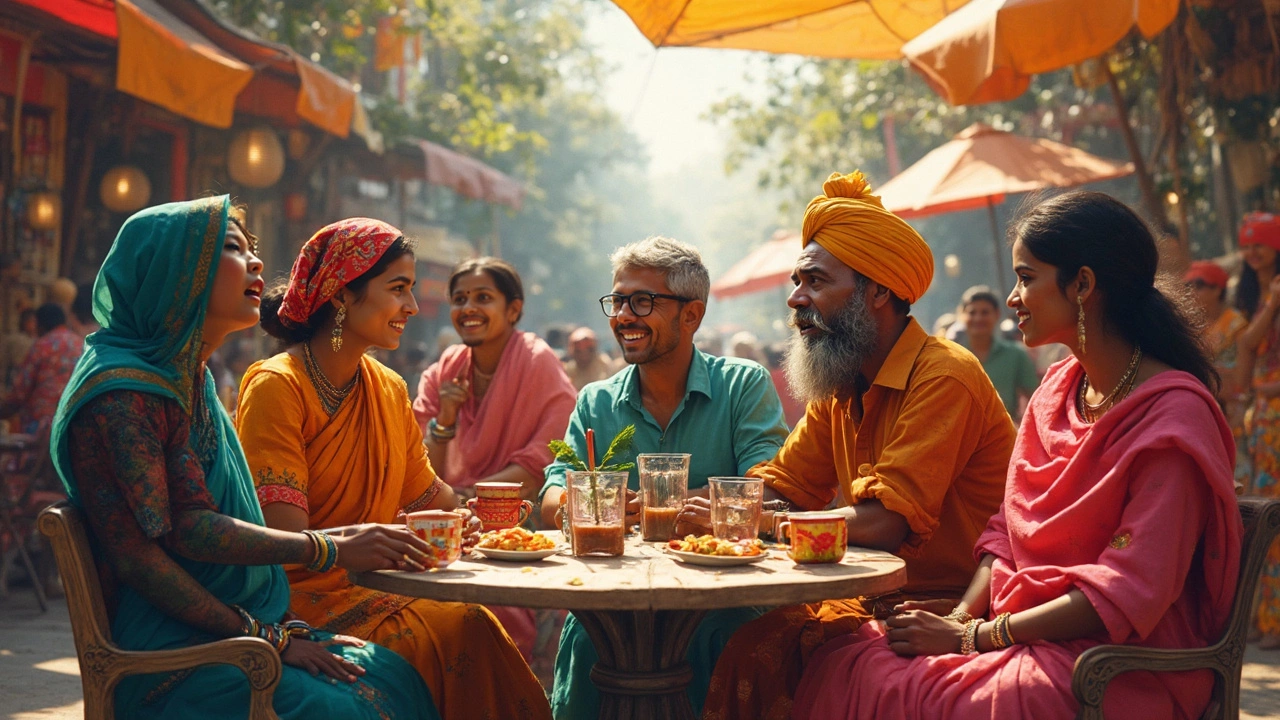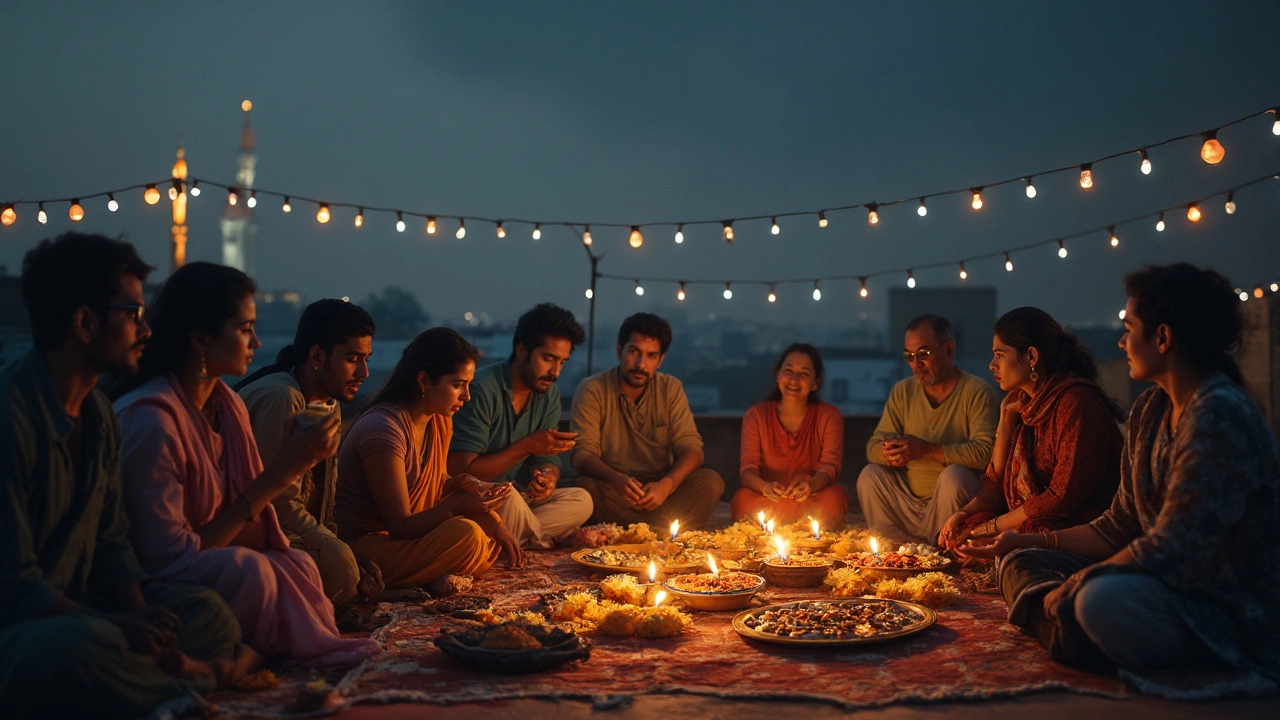Culturally Diverse Stories: What Are They and Why Do They Matter?
 Jun, 1 2025
Jun, 1 2025
Ever felt bored by stories that all sound the same? You’re not alone. Culturally diverse stories mix things up by bringing voices, ideas, and traditions into the spotlight that don't usually get much airtime. These stories can come from places you’ve never been, share perspectives you’ve never thought of, and show daily life in a way that’s both eye-opening and relatable.
When you dive into culturally diverse stories, you don’t just learn about different foods or clothing. You get real insight into what drives people—their dreams, struggles, humor, and even their frustrations. This richer world view helps you understand your neighbors, coworkers, and even the folks you see on TV a little better. And let’s be honest, the usual cookie-cutter characters just don’t cut it anymore. If you’re looking for ways to break out of your same old story routine and actually see the world in Technicolor, you’re on the right track.
- Defining Culturally Diverse Stories
- Why Representation Changes Everything
- Breaking Stereotypes and Opening Minds
- Finding and Sharing These Stories
- Tips for Creating Your Own
Defining Culturally Diverse Stories
So what exactly are culturally diverse stories? It’s not just stories set in faraway places or written in another language. These are stories that show the real-life experiences, beliefs, values, and voices from a wide range of cultural backgrounds. The point isn’t to make things exotic or unusual—it’s about showing people as they really are, including their everyday moments and big life events.
You’ll find these stories told by people whose backgrounds aren’t usually highlighted in popular movies, books, or news. In other words: these stories don’t just throw in a different character for show. They actually reflect what it feels like to grow up in different communities—whether it’s being part of an immigrant family in London, growing up in a small village in Kenya, or dealing with traditions and modern challenges in First Nations communities in Canada. The focus is on giving an honest window into realities that aren’t always talked about.
To spot a culturally diverse story, look for these things:
- It’s shaped by true cultural experiences—not stereotypes or clichés.
- The characters face real, day-to-day challenges based on their backgrounds, language, or where they live.
- The story lets you see what it’s like to walk in their shoes, not just watch from the outside.
- Local customs, languages, and family setups show up in authentic ways—not as jokes or props.
Culturally diverse stories aren’t a new fad. For example, the film "Minari" (about a Korean-American family in rural America) and the Australian TV series "Redfern Now" (made by and about Indigenous Australians) have both gotten international attention for doing this well. Even classics like the book “Things Fall Apart” by Chinua Achebe opened doors for readers to see the world through a different lens. These stories build empathy and smash the idea that there’s just one normal way to live or tell a story.
Why Representation Changes Everything
Seeing yourself in a story isn’t just nice—it’s powerful. When people notice someone like them in books, movies, or even ads, it boosts their confidence and changes how they see their own potential. It’s more than a self-esteem boost; it shapes who ends up thinking they can be a hero, a leader, or even just belong.
Let’s look at the numbers. A 2023 survey from the Cooperative Children's Book Center showed that nearly 42% of children’s books published in the U.S. had a main character of color. Compare that to just 15% back in 2014. That’s progress, but it still means most stories told in western media feature the same kinds of backgrounds and faces.
Why does this matter? Representation in culturally diverse stories leads to a bigger menu of ideas, cultures, and solutions. Think about with superheroes. When Marvel released “Black Panther,” the movie didn’t just break box office records—it inspired millions of Black kids worldwide. People suddenly saw themselves as tech whizzes, leaders, and royalty. When Disney made “Encanto” with its Colombian family, it gave Latinx viewers a movie that felt like home. It wasn’t just entertaining—it validated real experiences, showing others that these stories are just as normal and worthy as any others.
Here’s a quick look at how representation impacts media and society:
| Year | % Major Films Featuring Leads of Color | Children's Books with Diverse Protagonists (%) |
|---|---|---|
| 2014 | 12% | 15% |
| 2018 | 28% | 23% |
| 2023 | 37% | 42% |
Seeing a wider range of faces and backgrounds isn’t only for people from those groups, either. It helps everyone grow empathy and get curious about the world. If all you see are the same sorts of characters, you start to think that’s all there is. The flip side? When kids and adults see people not like themselves doing awesome things, it challenges stereotypes. It makes the real world feel more open, connected, and a whole lot more interesting.

Breaking Stereotypes and Opening Minds
The quickest way to make a story boring or tone-deaf? Stick to old stereotypes. The problem is, stereotypes flatten people into easy categories—like thinking all French folks wear berets or that every teenager is glued to their phone. These kinds of shortcuts show up everywhere: on TV, in books, and online. But here's something most people don't know: studies from the Pew Research Center in 2022 found that over 59% of audiences say they notice when a character just feels like another cliché. It can actually push people away from a story, not pull them in.
Culturally diverse stories cut through the laziness. Instead of rolling out the same old character templates, these stories show folks as real and complicated. Take "Never Have I Ever," the Netflix show—it features an Indian-American teen who deals with cultural expectations, grief, and crushes. Nothing about her story fits a mold. That's the key: showing the whole person, not just a label.
There’s a solid upside, too. Seeing accurate, detailed characters can help people see their own experiences reflected. It even makes a difference emotionally—kids who spot characters from their own backgrounds in books or movies tend to feel more confident and connected. This isn’t just talk; a 2021 Scholastic report found over half of kids say they "want to read books with diverse characters." Turns out, windows into new worlds and mirrors for our own lives help us all.
Sometimes, data puts it best. Check out these numbers:
| Fact | Source |
|---|---|
| Children's books with non-white protagonists (2023 in U.S.) | 39% |
| Adults who prefer media with diverse representation | 52% |
| Readers who say diverse stories changed their views | 65% |
So, what’s the takeaway? If you’re into culturally diverse stories, you end up challenging tired ideas, building bridges, and learning a ton. The world looks less black-and-white and way more interesting.
Finding and Sharing These Stories
If you’re tired of hearing the same voices, you’re probably wondering where to find genuinely fresh perspectives. The good news? It’s become easier than ever to discover culturally diverse stories if you know where to look. You can start by checking out book lists and award-winners—like the Coretta Scott King Award, the International Booker Prize, or the Lambda Literary Awards. These lists highlight authors and stories that put underrepresented cultures on center stage.
Streaming platforms like Netflix and Amazon Prime Video have entire collections of international films and series. For instance, "Lupin" from France and "Delhi Crime" from India have grabbed huge global audiences by telling stories that break away from the Hollywood mold. Don't overlook podcasts either—shows like "Code Switch" and "The Stoop" dive deep into real-life experiences from diverse backgrounds.
Social media is a goldmine too. Hashtags like #OwnVoices, #LatinxReads, and #BlackStories lead you to creators and influencers sharing authentic takes on their communities. Many local libraries now run "diversity book clubs" or community meetups where you can hear stories straight from the source. Even universities are getting in on it by hosting cultural storytelling nights and publishing online anthologies featuring student voices from all over the globe.
When it comes to sharing, the trick is boosting these stories so more people see them. Leave reviews for diverse books and shows on platforms like Goodreads, YouTube, or Letterboxd. Shout out your favorites on your social feeds. If you run a blog, newsletter, or even a group chat, recommend what’s moved you, and explain why it matters. Collaboration helps too—invite guest writers, host events, or team up for cultural spotlights at your workplace or school.
Bottom line: every time you pay attention to and share a story that’s off the usual path, you help make sure more perspectives get heard. It’s not just good for the people telling those stories. It’s good for all of us who want a world that actually feels real and connected.

Tips for Creating Your Own
Want to write or tell your own story that actually stands out? It doesn’t need to be rocket science. The first step is keeping things honest. Write about your real experiences—or if you’re sharing someone else’s background, get the facts straight and show respect for their culture. It’s called cultural authenticity, and readers spot the difference right away.
If you’re serious about jumping in, here are some steps to help you put together a story that feels fresh and represents real cultural diversity:
- Research, research, research. Even if you belong to a culture, things change from city to city, family to family. Look into food, language, traditions, history, and how daily life varies. For example, a “Mexican” story from Tijuana will feel totally different from one from Oaxaca.
- Talk to people who know. Interview folks, ask relatives, or listen to stories straight from the source. Firsthand details are gold.
- Stick with what’s real. Don’t fall into the trap of using stereotypes or one-dimensional characters. Show both the everyday stuff and the unique things that matter to a group.
- Mix languages if it fits. Including a few words or phrases in a different language gives it flavor. Just make sure your meaning is clear, and maybe toss in a quick translation right after.
- Check your story with someone from that culture. Let them read it and point out if anything feels off or cringeworthy. Sensitivity readers are a real thing in publishing—big publishers like Penguin Random House started using them around 2016.
Adding actual data to your process helps too. For instance, organizations like We Need Diverse Books have pointed out that as of 2023, only about 39% of kids’ books published in the U.S. featured characters from diverse backgrounds. This means there’s plenty of room for new voices and stories.
| Year | US Kids’ Books Featuring Diverse Characters (%) |
|---|---|
| 2015 | 22 |
| 2018 | 27 |
| 2021 | 35 |
| 2023 | 39 |
When building your own culturally diverse stories, remember—someone out there is waiting to see a bit of their own world reflected in what you create. Keep it real, be open to feedback, and you’ll give your audience something worth remembering.